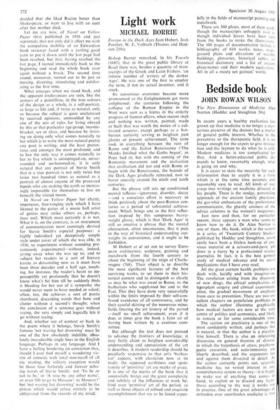Light work
MICHAEL BORRIE
Europe in the Dark Ages Jean Hubert, Jean Porcher, W. F. Volbach (Thames and Hud- son 210s)
Bishop Burnet remarked, in his Travels (1687), that in the great public library at Basel there was, besides a quantity of man- uscripts of the Greek and Latin Fathers, 'an infinite number of writers of the darker Ages'. He was one of the first to employ the term, if not its actual inventor; and it stuck.
Its censorious overtones became more pronounced as the Enlightenment got more enlightened: the centuries following the collapse of the Roman Empire in the West were seen as a hiatus in the orderly progress of human affairs, when reason slept and nothing was written, painted, made or built that was worth the notice of a cul- tivated amateur, except perhaps as a bar- barous curiosity serving to heighten past glories or present achievement. The term took in everything between the ruin of Rome and the Italian Renaissance (`The Monks finished what the Goths begun', as Pope had it), but with the coming of the Romantic movement and the realisation that civilisation did not end with Rome or begin with the Renaissance, the bounds of the Dark Ages gradually retreated, now to hover uneasily around the ninth and tenth centuries.
But the phrase still sets up conditioned mental reflexes—ignorance, disorder, decay —and a conscious effort is necessary to think positively about the post-Roman cen- turies as a period of substantial achieve- ment. Which brings one to the first reflec- tion inspired by this sumptuous heavy- weight glossy, which is that 'Dark Ages' is still so emotive a phrase that the mental obstruction, often unconscious, that it puts in the way of historical understanding out- weighs its convenience, and it ought to be forbidden.
M Hubert et al set out to survey Euro- pean architecture, sculpture, painting and metalwork from the fourth century to about the beginning of the reign of Charle- magne (768). Their object is to describe the most significant features of the best surviving works, to set them in their his- torical context and to distinguish as clearly as may be what was owed to Rome, to the barbarians who supplanted her and to the
East. This they have done very successfully within the limits imposed by their self-con- fessed avoidance of all controversy, and by their careful skirting of the numerous mine- fields littering the art history of the period —itself no small achievement, even if it does at times give the book a faint air of
having been written by a cautious com- mittee.
But although the text does not pretend
to advance the frontiers of knowledge, it may fairly claim to heighten considerably understanding and appreciation of the art it describes. A modern readership should be peculiarly responsive to that art's 'barbar- ian' aspects; with classicism now at its nadir, the supposed earthiness and spon- taneity of 'primitive' art are marks of grace. It is one of the merits of the book that it successfully brings out the great complexity and subtlety of the influences at work be- hind even 'primitive' art of the period, as well as those objects of refined and exquisite accomplishment that are to be found espec-
ially in the fields of manuscript painting and metalwork.
There are 360 plates, most of them good, though the manuscripts unhappily look as though individual leaves have been tom from the books to make the illustrations. The 100 pages of documentation include a bibliography of 610 works, notes, maps, ground plans and elevations of notable buildings, glossaries, historical tables, an historical dictionary and a list of ancient place-names and their modern equivalents. All in all a meaty ten guineas' worth.


































 Previous page
Previous page